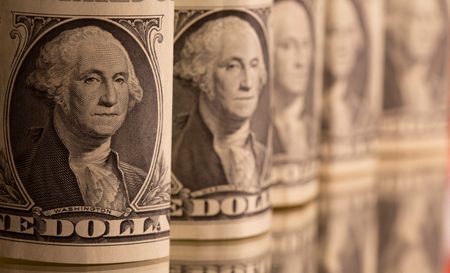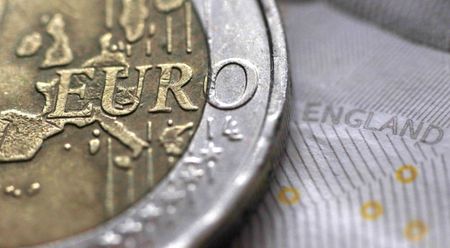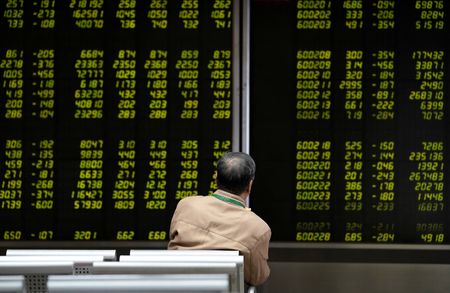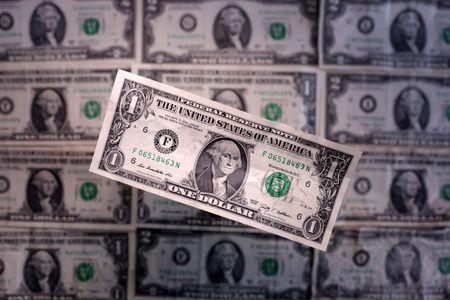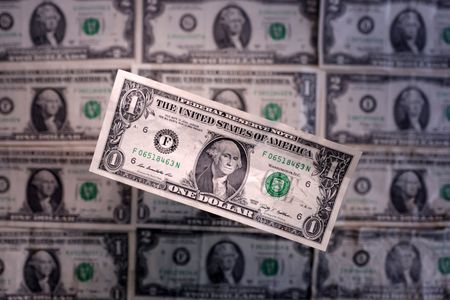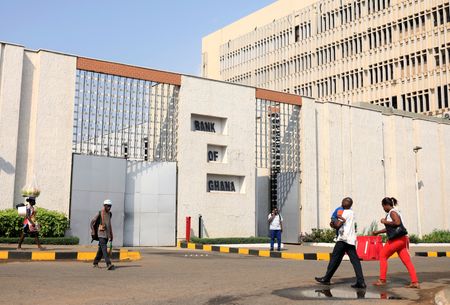By Karen Brettell
NEW YORK (Reuters) -The dollar slipped on Thursday after components of January’s producer price report pointed to lower inflation, and fell further after the White House said that reciprocal tariffs on other nations would not be implemented immediately.
Producer price data on Thursday indicated that core PCE inflation, the Federal Reserve’s preferred measure, is likely to be lower than previously expected for January when it is released later this month.
It came despite producer prices rising more than economists expected.
“There were some subcomponents in there that show that PCE might not be as hot as CPI suggested,” said Noel Dixon, global macro strategist at State Street Global Markets.
The producer price report came after Wednesday’s Consumer Price Index for January was much higher than expected, leading traders to price in fewer rate cuts this year.
Futures traders are now pricing in around 33 basis points of cuts by December, up from 29 basis points before Thursday’s data, but down from 37 basis points before the CPI data was released on Wednesday.
The Personal Consumption Expenditures Price Index is due on February 28. Economists at Morgan Stanley revised their core PCE inflation expectation for January to 0.3%, from 0.4%, after Thursday’s data.
The dollar index was last down 0.61% on the day at 107.25, the lowest since January 27. The euro rose 0.58% to $1.0442 and earlier reached $1.0446, the highest since January 30.
The Japanese yen strengthened 1.05% against the greenback to 152.8 per dollar.
The greenback briefly pared losses before falling to lower levels after U.S. President Donald Trump said he would levy reciprocal tariffs on every country that charges duties on U.S. imports.
The tariffs were not going into effect on Thursday but could begin to be imposed within weeks as Trump’s trade and economic team study bilateral tariff and trade relationships, a White House official told reporters.
The announcement appeared designed at least in part to trigger talks with other countries. The official said Trump would be more than happy to lower tariffs if other nations lowered theirs.
“The message from Trump seems to be that – we’re going to get you, but not today. And the market seems to take comfort from that,” said Steve Englander, Head, Global G10 FX Research and North America Macro Strategy at Standard Chartered Bank’s NY Branch.
The euro and other European currencies including the Swiss franc, Swedish krona and Norwegian krone were also boosted on optimism that Russia and Ukraine could reach a peace deal.
“It’s telling you that geopolitics in that part of the world is calming down a little bit,” said Englander.
Trump discussed the war in Ukraine on Wednesday in phone calls with Russian President Vladimir Putin and Ukrainian President Volodymyr Zelenskiy, the new U.S. president’s first big step towards diplomacy over a war he has promised to end.
Meanwhile, the U.S. dollar remains attractive with the U.S. economy still growing well above trend, said State Street’s Dixon, adding that U.S. tariffs and immigration restrictions in the U.S. are also likely to add to inflation, while tariffs could further dent growth in the euro zone.
“The overarching trend for the dollar is higher,” Dixon said.
Sterling gained after data showed that Britain’s economy unexpectedly grew by 0.1% in the final quarter of last year. It was last up 0.8% at $1.2541.
In cryptocurrencies, bitcoin fell 2.01% to $95,716.98.
(Reporting by Karen Brettell; Editing by Ros Russell and Andrea Ricci)

